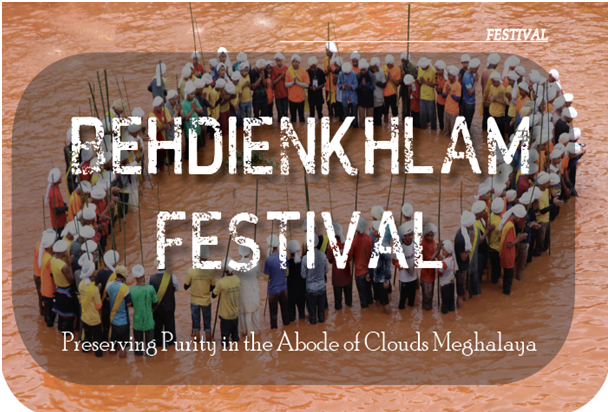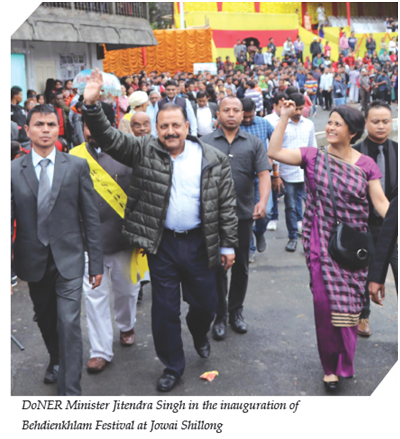
Forming one of the main regions of the beautiful state of Meghalaya, one of India’s most popular tourist attractions, the Jaintia Hills are famous for the way they have held on to their tribal culture even today, in an age of modernism. One of the most important features of the tribal charm of Meghalaya is the Behdienkhlam Festival, (June-July) which remains as one of the most popular festivals of the region.
The Behdienkhlam Festival is celebrated by the Pnars as a form of homage which is paid to the Gods of the Seven Huts who arrived in the region from heaven and established a kingdom here. A prediction claimed that the region would suffer a violent plague that threatened to wipe out the entire tribe. Scared by this ill-fortuned prediction, the Jowai people travelled to the shrine of their protector deities Mulong, Mooralong U Mukhai and Musniang who advised them to worship the divine elements in the form of the festival of Behdienkhlam which was to be held annually. Thus, the festival is also known as the festival for chasing away the Demon of Cholera. Today, however the festival has another important significance. It is used as a prayer seeking divine blessings for a rich harvest in the year ahead. The biggest festival is also celebrated in Tuber Kmaishnong village. It’s the most significant festival in the socio-economic life of the Jaintia people those who believe in the Niamtre or traditional faith. Jaintia tribesmen carry a traditional Rongsa or chariots and dance on the occasion of their age old Behdienkhlam festival in Tuber village Meghalaya. The event is the most important dance festival of the Jaintia people and is celebrated after the sowing period is over to invoke the blessings of the Gods for a beautiful harvest and the good health of the people and to drive away plague and diseases.
which is paid to the Gods of the Seven Huts who arrived in the region from heaven and established a kingdom here. A prediction claimed that the region would suffer a violent plague that threatened to wipe out the entire tribe. Scared by this ill-fortuned prediction, the Jowai people travelled to the shrine of their protector deities Mulong, Mooralong U Mukhai and Musniang who advised them to worship the divine elements in the form of the festival of Behdienkhlam which was to be held annually. Thus, the festival is also known as the festival for chasing away the Demon of Cholera. Today, however the festival has another important significance. It is used as a prayer seeking divine blessings for a rich harvest in the year ahead. The biggest festival is also celebrated in Tuber Kmaishnong village. It’s the most significant festival in the socio-economic life of the Jaintia people those who believe in the Niamtre or traditional faith. Jaintia tribesmen carry a traditional Rongsa or chariots and dance on the occasion of their age old Behdienkhlam festival in Tuber village Meghalaya. The event is the most important dance festival of the Jaintia people and is celebrated after the sowing period is over to invoke the blessings of the Gods for a beautiful harvest and the good health of the people and to drive away plague and diseases.
Concluding Ceremony
The festival of Behdienkhlam reaches its conclusion with the Dad-lawakor ceremony in which groups of men jostle for the possession of a wooden ball, a game which is remotely similar to football. The festival ends with a final salutation to the divine powers when the women of the tribe offer sacrificial food to the Almighty.
EP Desk
To read the further article please get your copy of Eastern Panorama August issue @http://www.magzter.com/IN/Hill-Publications/Eastern-Panorama/News/ or mail to contact @easternpanorama.in


